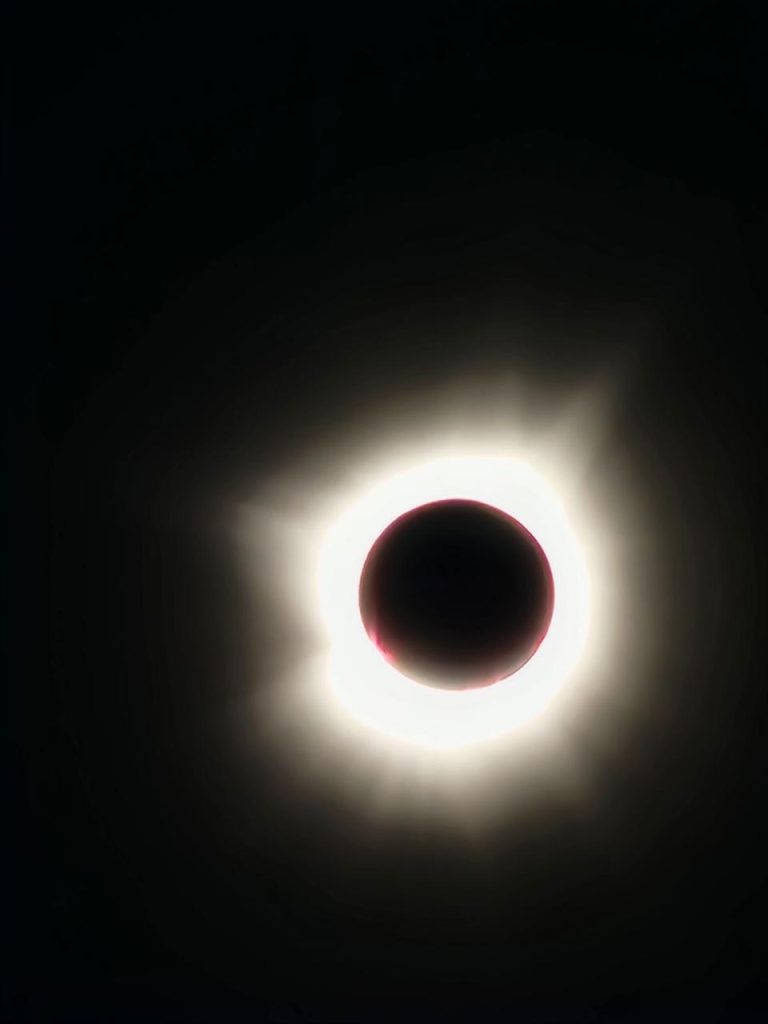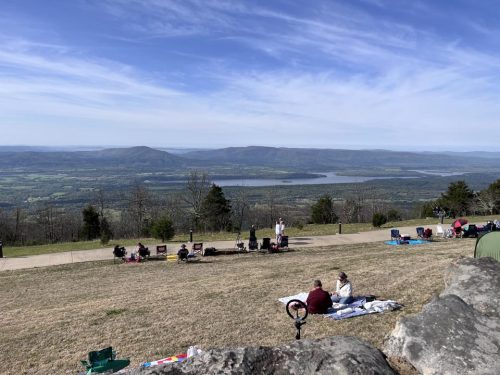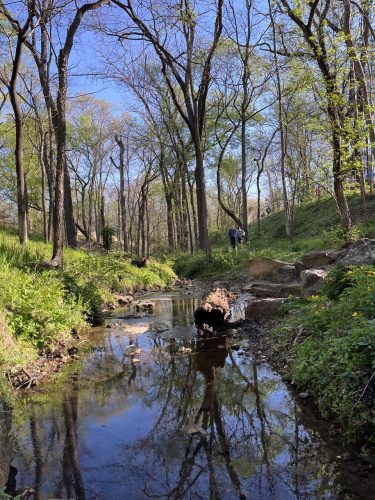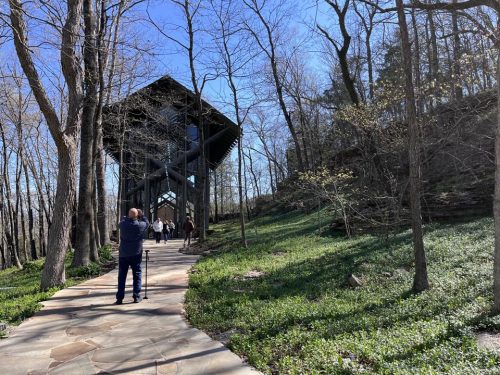Main Event Not ECLIPSED
Our columnist celebrated her birthday viewing a total eclipse of the sun in Arkansas.


Last week, I described our visit to Bentonville’s Crystal Bridges Museum and my selection of Arkansas for viewing the eclipse. Crystal Bridges was a Friday night and Sunday experience. Now for our Saturday explorations: We began our day at the Compton Gardens and Arboretum. The garden’s mandate focuses on native plants as does Crystal Bridges. Here we were first struck by the youthful energy of Bentonville. The median average age in the United States is 38, in Arkansas it is 37, and in Bentonville it is 31.
A wide path in the Gardens was crowded with a sea of runners competing in a half marathon, a 5k ,and a relay race. There were an estimated 3,800 participants on the 13.1-mile course. However Bentonville’s real athletic passion is mountain bicycling. It’s known as the “Mountain Biking Capital of the World,” with more than 70 miles of trails running throughout the city associated with an additional 400-mile system of trails that connect “bluffs and hollers” throughout northwest Arkansas. It seemed to me that every four cars was “required” to have bicycle racks or alternately be a pickup that can hold six bikes.
The Arboretum hosts a section of this 70-mile labyrinth of trails. To my eyes the concrete track with its four-foot concrete curved banks is harrowing and death-defying. Only centrifugal force keeps the rider from crashing. These cement banks alternate between dirt paths and all kinds of man-made topography. Evidently, Arkansas is not as litigious as New Jersey. I suspect their policy is that if you’re that gifted or crazy, what happens to you is not anyone’s fault but your own.
What I witnessed looked challenging and in fact downright nuts. But when I inspected photos of what is possible upon these 70 miles of fun-filled terror it blew my mind. Some sections looked like an elevated rope course for cyclists!
Oh, yes, the Gardens: They celebrate the rich history of Arkansas’ native plants on seven acres that connect to the Crystal Bridges grounds. Conservationist Dr. Neil Compton led the fight to protect Ozark Buffalo River environs. In addition to the aforementioned trails, Compton Gardens has walking paths and “Champion Trees” (registered with the Arkansas Department of Agriculture for their girth and grandeur).
As in the adjacent Crystal Bridges we saw ephemerals including blue bells, mayapples, and celandine poppies. We also spotted wild ginger and lots of ragwort.

We were fortunate to have two architects and a builder in our entourage, so it was time to see some more man-made wonders. Bentonville’s West Central Avenue historic district boasts 40 homes, circa 1885 to 1935, that represent a concentration of fine residential architecture of the period. These include examples of both Craftsman-period and Italianate homes.
Next we were off to visit Thorncrown Chapel on the outskirts of Eureka Springs. This 48-foot-tall wooden and glass structure has 425 windows and more than 6,000 square feet of glass. It truly brings the outside in! Its foundation consists of 100 tons of native stone and colored flagstone. Designed by E. Fay Jones, an apprentice of Frank Lloyd Wright, the chapel has had more than seven million people visiting since it opened in 1980.
Jim Reed, a retired teacher who purchased property for building his retirement home, was inspired and determined to build an interdenominational chapel on his 26 acres. He approached Jones to design the place of worship. Jones dismissed the idea until in conversation with Reed he discovered they were both from Pine Bluff, Arkansas, and they proceeded to reminisce about a favorite second-grade teacher. Even after the project was underway, Jones thought that although it was a great design, no one would ever see it completed.
Funding presented major hurdles but Reed was determined. In the end a private lender enabled him to complete his dream. He set an opening date of June 15, 1980, but the site was a disastrous mess just weeks beforehand. His son Doug, knowing how important the chapel was to his father, gathered some college chums and they managed to clean it up on a college break in time for its unveiling.
His father charged an admission fee of $2.34 at the base of a hilly driveway leading to the chapel. No one came even though the entrance was on a busy route. Doug knew how disappointing this was for his father.
Doug relayed, “One day a fellow in cutoff shorts wandered down the chapel trail and asked to photograph the Thorncrown. My dad said, ‘Why not?’ He did not know this young man was the renowned architectural photographer Greg Hursely. In a matter of months, the chapel appeared on the cover of every major architectural magazine in the country, and overnight everything changed. People came first by the hundreds and then by the thousands. This is the power of a photograph.”

On April 7, 2024 we became just two of the thousands to be embraced by the chapel’s glass structure and beams. Eureka indeed.
Reading that Eureka Springs is known for its preserved Victorian buildings we decided to check them out. The town was founded by an entrepreneur, Dr. Alvah Jackson, and best I can tell from our guided tour, also by snake oil salesmen, who boasted the town had healing waters. The town was founded in 1879 and by 1881 it became the fourth largest city in Arkansas based on claims of the special qualities of its streams. Basin Spring was the source of this elixir and Jackson was a good salesman.
Eureka is best known for its multi-storied Victorian homes. Envision that you can enter the front door on the top or middle story and exit the house on a story three or five floors down. In this way Eureka acquired nicknames like “America’s Little Switzerland,” “The Town that Climbs the Mountain,” and “The Stairstep Town.”
Since 1970 the entire town has been listed on the National Register of Historic Places, or the Eureka Springs Historic District. The City’s website boasts that there are more than 100 restored mansions serving as bed and breakfasts, and hundreds of historic cabins and cottages.
The downtown shopping area was hopping with tourists and the excitement of a “Diversity Day Celebration.” At one point our open-air trolley was greeted by about eight Dame Ednas, one flashier than the next. Well done, gentleman! The town had the vibe of a New Hope and Cape May falling off the hillsides.
As mentioned in last week’s installment we spent Sunday back at Crystal Bridges American Museum of Art.
Then on Monday, April 8, we prepared for a possible nightmare driving experience as we set our goal on “Totality or Bust,” thanks to a tiny white car in front of us with a huge sign declaring the same. We departed at 6 a.m. for a 2.5-hour drive to Mount Magazine State Park, Arkansas’ highest point at 2,753 feet. The eclipse stats: 3 minutes and 54 seconds of totality, 12:32 p.m. start of partial eclipse, 1:49 p.m. start of total and 3:09 p.m. end of partial.
The Arkansas State Parks were eclipse-ready. This area normally has 1,000 parking spaces but they planned to open as many as 3,000. The park representative I spoke with a week before the eclipse said they feared they would be full by 7 a.m., at which point they planned to close the entrance to the park. But when we arrived at 9 a.m. we were pleasantly surprised to find the main lodge still had plenty of spaces. From the main lodge’s deck we had an unimpeded view of the valley and Blue Mountain Lake. Drop-dead gorgeous!
Visitors were quite spread out. The park’s 2,200 acres gave lots of possibilities where you could stake out a spot. We avoided Russellville, at the center of totality, because 200 people were getting married there. I suppose they wished to ensure their tying of the knot was memorable. I was married 44 years ago and have no difficulty remembering it, so that was not entirely necessary.

At Mount Magazine we had the pleasure of making the acquaintance of April Kiser, the new deputy chief of communications for Arkansas State Parks. She was delightful, we had some fun conversations, and she joined our group to watch the eclipse. In short course I was on Channel 5 CBS news being interviewed about why and how we had chosen Mount Magazine for viewing the eclipse.
“Why was I there?” For starters, when we began planning our trip the website for the Arkansas state parks was unusually well-organized. It included a map and time characterization for all the parks on the path of totality. Each park was well described and mapped. In fact the entire state’s park system looked amazing.
I decided that it was where I wanted to celebrate my birthday and where I wanted to witness totality. Arkansas’ topography is beautiful, full of sensational views, and the people are friendly and hospitable.
On the deck beneath us was a small entourage from New Orleans and a woman there was celebrating her birthday, too. In the lobby there was a world map where you could place a pin on your hometown. There were pins from all over the world.
When the big moment came it did not disappoint. We had clear skies. Black vultures stopped soaring as the skies grew dark, the air cooled, and then the valley was cloaked in black. Spontaneously people clapped. As it concluded and the sun shone brighter, I played the Beatles’ “Here Comes the Sun” from a playlist of 60-some moon and sun songs I had made for our drive to the Mount!
There we were, people from everywhere gathered to enjoy one of nature’s great spectacles. And there was peace and commonality; what a great birthday! See you in 20 years!
Source:
- Thorncrown Chapel brochure.
- Fay Jones and Jim Reed, The story and meaning of Thorncrown Chapel, as told by his son Doug Reed. https://thorncrown.com/fayjones1.html









